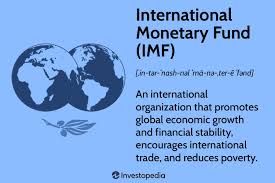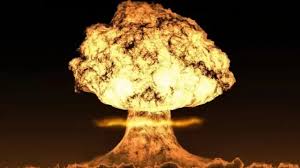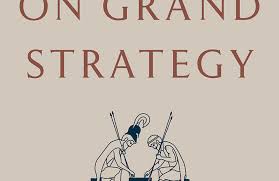Introduction-Imf

INTRODUCTION – IMF
Reference to be provided by Prof. Khurshid
15 September 2008
| Prof. Khurshid Ahmad |
INTRODUCTION-IMF
Prof. khurshid Ahmad
IMF has virtually become a dreadful word in the vocabulary of the people of Pakistan, as also of a host of other developing countries. An institution that was established to promote global financial stabilization, particularly by providing much needed balance of payments support to countries caught in trade deficits and by managing stable exchange rates, avoiding frequent devaluations, trade disruptions and resort to protection, is now being looked upon not as a ‘guardian of global financial stability’ but as one responsible for promoting instability and socio-economic inequity.
Globalization, that was expected to bring up all and sundry, strong and weak is regarded by vast majority of people of the world as primarily an instrument and a process to promote the interest of the rich and powerful, to the detriment of the poor and weak of the world. Despite wave after wave of globalization, the world has become more unjust, more instable and more divisive. The question that is being asked with deep concern is whether all this is the result of some fundamental flaw in the very vision and statement of the international monetary and economic institutions established to provide relief and rehabilitation to a war ravaged world or is the failure due to faulty implementation of an otherwise suitable arrangement? Where the fault lies: in the very framework or the mistakes of the players. Perhaps both!
As the Second World War approached its end, the world leaders deliberated on a new vision of a world order that could protect mankind from the scourge of another global Armageddon and a repetition of the economic and financial tsunamis that wrecked the world economy in the 1930’s. Consequently a new political infrastructure in the form of the United Nations, the U.N. Charter of Human Rights, the International Court of Justice, a new set of Geneva Conventions and a host of other sister international institutions, was visualized and established. To ensure economic and financial stability, expanding trade flows, and promoting socio-economic development the Bretton Woods agreement gave birth to institutions like the International Monetary Fund (IMF), the World Bank (WB), the General Agreement for Trade and Tariff (GATT) and eventually World Trade Organization (WTO). The objectives were laudable and each of these institutions has served some good purpose. Yet, they did not prove unmixed blessings. The politico-economic context had its toll. WTO took too long to see the light of the day. IMF and the World Bank failed to move in the directions originally visualized. Peace and development remained elusive for most of the parts of the world. Soon the world was caught in the grip of a new cold war. Old colonialisms lost their breath; but new ones plunged into the arena with greater sophistication. The institutions that were established to promote peace, justice and equal opportunities for all, became instruments in the hands of the new hegemons. That is how some very useful initiatives got frustrated or derailed.
IMF has traversed at least three phases. Originally it was a key player in maintaining exchange rate stability for the developed countries of the world. Its role in the developing world remained rather marginal. Things changed in 1971-1973 when due to collapse of the fixed exchange rate regimes dollar was delinked from gold and the era of fixed exchange rate came to an end. The third world countries were the worst sufferers and in the post- 1973 era IMF’s role in the developing countries increased manifold. In fact they become the chief arena for its operations. It was during this phase that the new concepts of ‘conditionalities’ and ‘structural adjustments’ were evolved, concepts which had no place in the original Bretton Woods model of the IMF. The developing world has, during the last forty five years born the brunt of this new role of the IMF. It has gone far beyond the realm of balance of payment support. Now it’s critical role was to bring about structural transformations in countries seeking its facility. Promotion of market capitalism became the prime objective. Liberalization, privatization, de-regulation and market economy became the major policy targets. The IMF facility was no longer confined to simple balance of payments support and exchange rate management. It was extended to the uncharted realm of macro-economic stabilization. The approach became much more intrusive and interventionist. The political context also became central. To put things bluntly, the promotion of Global Capitalism and pursuit of the foreign policy objectives of the United States and Europe. This has led to disastrous consequences for the poor and the developing countries of the world.
The third phase, an aspect and extension of the second phase, is represented by the role assumed by the IMF in respect of the Capital Market liberalization in the light of the Hong Kong Protocol of 1997. Consequently capital market liberalization was thrust upon the third world countries, without any regard to the state and stage of their capital markets, and the capacity of the respective economies to absorb international capital flows and withstand their shock waves. This led to further worsening of the situation with increased instability and added vulnerability. It is the developing world that has mostly suffered as a result of these international adventures ideological conquests.
This metamorphoses of the role of the IMF over the last six decades and its mostly one-dimensional approach to the whole complex issue of economic development and social equity lie at the root of the present predicament of the third world. The disenchantment is most universal — south and South East Asia, South America and Africa all in the same boat. It would be unfair to suggest that IMF has not played some positive role in some parts of the world. But whatever good it has contributed to is over- shadowed by the negatives generated as a result of its policies. At least three things deserve to be noted in all frankness to understand the delirious consequences of its policies in Pakistan and the developing world.
First and foremost the IMF has not operated as it was visualized in the original scheme of things. It has acted not as a neutral international institution committed to the good of the world community, but as an instrument of global capitalism and a vehicle for the promotion of US foreign policy interests. Behind all its technical advice is an ideology and a political objective. And as the US veto is built into its organizational structure, it has no capacity to act independently. That has robbed it of its role as an independent actor and facilitator. In fact, the countries that come under the shadow of its facility have to surrender a vital part of their sovereignty. This is the heaviest price they have to pay to avail of the IMF support.
Secondly, the prescription the IMF has developed in the form of its Structural Adjustment Programme, including the so-called Poverty Reduction and Growth Facility, is not tailored to the varied needs and problems of the recipient countries. Instead it is doctrinaire, and one- dimensional, lead on the so-called Washington Consensus. What has been described as its “one-size-fit-all” approach is the real bane of the entire current IMF strategy. The key issues of growth with equity, of employment generation, of distributive justice are conveniently by-passed. It is all the more worrisome that despite an almost universal failure of this approach, the IMF strategists have by and large remained committed to this very approach. That is why wherever a country is forced to approach the IMF; it is scared of this inflexible approach and intrusive encroachments on national sovereignty and people’s vision of their needs and development.
The third issue is primarily structural. While the developed countries of the world talk of democracy day-in and day-out the international political and financial infrastructure they have built is elitist and protective of their own hegemonistic roles. The U.N. is a hostage to the veto of the big five. The IMF has a voting structure which gives veto powers to the US and a dominant role to the developed countries. Even the Articles of Agreement can be changed only with an 85% majority, which is impossible became US has 17% voting rights. It is this built-in power-game that has rendered the IMF much less effective than what it could have been, if it were really independent, neutral and democratic.
It is because of these three fundamental flaws that the IMF experiment fails to inspire the confidence of those people of the world who need its services most. Noble Laureate Joseph Steglitz says with deep concern and grief that:
- A half century after its founding, it is clear that the IMF has failed in its mission. It has not done what it was supposed to do — provide funds for countries facing an economic downturn, to enable the country to restore itself to close to full employment. In spite of the fact that our understanding of economic processes has increased enormously during the last fifty years, and in spite of IMF’s efforts during the past quarter century, crises around the world have been more frequent and (with the exception of the Great Depression) deeper. By some reckonings, close to a hundred countries have faced crises. Worse, many of the policies that the IMF pushed, in particular, premature capital market liberalization, have contributed to global mobility. And once a country was in crisis, IMF funds and programs not only failed to stabilize the situation but in many cases actually made matters worse, especially for the poor. The IMF failed in its original mission of promoting global stability; it has also been no more successful in the new- missions that it has undertaken such as guiding the transition of countries from communism to a market economy.
(Joseph Striglitz, Globalization and Its Discontents, Allen Lane, 2002, P.15)
He reaffirms this conclusion in his latest book Making Globalization Work (Allen Lane, 2006):
- I became convinced that the advanced industrial countries through international organizations like the International Monetary Fund (IMF), the World Trade Organization (WTO) and the World Bank, were not only doing all that they could to help these countries but were sometimes making their life more difficult. IMF programmes had clearly worsened the East Asian crisis, and the “shock therapy” they had pushed in the former Soviet Union and its satellites played an important role in the failure of the transition.
(P.ix-x)
Steglitz states the obvious when he says:
- Whatever the conditions imposed by the IMF, they will be objected to simply because they are imposed — they come from outside the country. But IMF conditions are especially objectionable because they are often so ill-suited for the country. The IMF has become so obsessed with inflation that it often seems to forget about growth and real stability —paying little attention to volatility in output and employment. As a result, rather than remedying the deficiencies in private capital markets or offsetting the effects of these deficiencies, it has often worsened them. Rather than providing funds to finance counter-cyclical policies, it has typically demanded that countries undergoing a downturn impose contradictory policies. One of the most important advances in economics over the past century was the insight of John Maynard Keynes that government, by spending more and lowering taxes and interest rates, would help countries recover from a recession. The IMF rejects these Keynesian policies, adopting instead pre-Keynesian policies focusing on government deficit; these entail raising taxes and cutting expenditures in recessions, just the opposite of what Keynes recommended. In virtually every case where they were tried, IMF policies worsened the downturn.
Especially problematic are the high interest rate policies that the IMF pushed to stabilize exchange rates; while the high interest rates failed to do that, they quickly led to an exposition of the debt burden. Governments had to borrow more and more just to make the interest payments on what was owed.
The policies the IMF pushed as a condition of loans hurt the borrowing countries in other ways even countries that borrow moderately may face a problem as a result of the high level of economic volatility, including volatility of exchange rates and interest rate. Capital market liberalization (which the IMF urged, or forced upon developing countries) exposed countries to more risk and volatility, and limited their ability to respond.
(P.235)
The IMF strategists are following a doctrinnaire approach and have failed to learn from wide-spread failures of these conditionalities and from the insights so clearly articulated by the concerned scholars. The reason, perhaps, lies in the ‘conditionalities’ within which the IMF operates itself. And that is why wherever a country is on the verge of approaching the IMF for its facilities all these aspects have to be kept in mind. The country’s – vital interests must be protected. Pakistan was able to liberate itself from the IMF bondage in 2004, but now it seems it may once again be on the verge of approaching the IMF, for support. It is important that the nation should be reminded of the country’s experience in the past, particularly what it had to undergo during 1988-2004 and also to spell out in clear terms the dynamics of the IMF chessboard. It is in this context that I welcome the publication of the present study on the IMF by our senior colleague as former chief Economist Govet. Of Pakistan Mr. Fasihuddin. This study of IMF and Pakistan’s experience is timely and illuminative. It goes beyond description. It is analytical and evaluative. It is also a warning and a wake-up call. Therein lies the relevance and usefulness of this incisive review of over five decades of Pakistan’s encounters with the IMF. Before I conclude let me say that the current economic situation in Pakistan, external resources are depleting fast, forex reserves have run down by over seven billion dollars in a span of six months. Balance of trade and balance of payments, situation is alarming. Rate of Exchange is fluctuating steeply, almost 17% devaluation in half a year.
The failure and blunders of the Musharraf-Shaukat Aziz Government are unforgivable but the lack of direction and absence of firm grip on policy of the present government too cannot be ignored. It would be a blunder to go to the IMF in a state of desperation and hurry. The political and economic challenges are acute. But they call for more mature response. The need to seek immediate relief, within the context of a medium term development plan. The IMF is not the only resource in a situation like this. There are other alternatives within and without that must not be left untapped. The real issue is one of political stability and appropriate policy response to structural problems that cannot be corrected by IMF medication. Everything cannot be left to the market, although market has to play a vital role. It is important to rediscover the role of the government and a new healthy and balanced equation between the private and public sectors are need of the honor Self-reliance must become a central policy- objective. Self-reliance is neither self-sufficiency not autarky. It is not a static concept either. But we can ignore it only at our peril. We also want to suggest that indiscriminate privatization too is not the answer. Nor is total and unplanned withdrawal of subsidies a sure recipie for economic reform. Development and equity must go hand-in-hand. In that context targeted subsidies must not be ruled out under outside pressure. Fiscal discipline is important but not the one that denies resources to development, employment generation capacity-building and support for the poor and the down-trodden. The productive use of foreign remittances and drawing on the huge resources of the Pakistani expatriates must not be neglected. In view of the current global economic rundown and financial crisis, Pakistan and other developing countries could become safe investment havens for the over a trillion petro-dollars in the Middle East that are seeking avenues for investment. Political stability, proper economic planning and efficient marketing can open up new avenues of resource mobilization. Instead of going by the book, the; present Government may choose to tread new paths for domestic and external mobilization to achieve development with equity. There is no limit to options provided our leadership has vision and viable plans for action, political and economic initiatives. It is time to chalk out a course of action that is based on experience of the past, current challenge is capable of seizing opportunities of today and tomorrow.
The present work is a mirror of the past; it has a lot of light that can guide the course of the future. I hope our policy makers learn from the past and avoid the mistakes that have marred our rendezvous with destiny.





